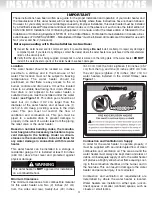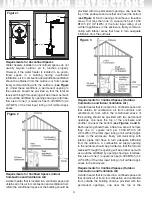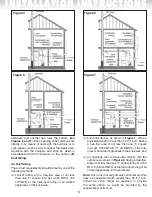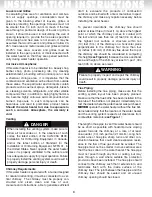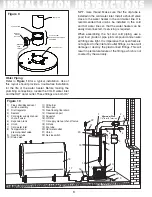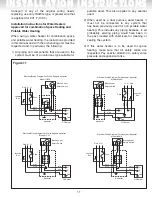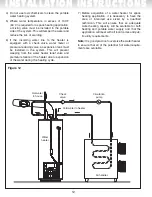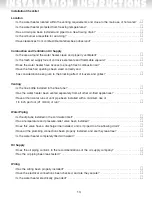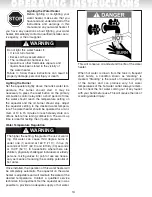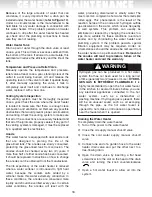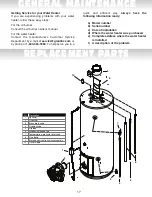
INSTALLATION INSTRUCTIONS
Louvers and Grilles
In calculating free area for ventilation and combus-
tion air supply openings, consideration must be
given to the blocking effect of louvers, grilles or
screens protecting the openings. Screens must not
be smaller than 1/4 inch (6.4 mm) mesh. If the free
area through a particular design of louver or grille is
known, it should be used in calculating the size of
opening required to provide the free area specified.
If the design and free area is not known, it may be
assumed that wood louvers and grilles will allow 20-
25% free area and metal louvers and grilles will allow
60-75% free area. Louvers and grilles must be
installed in the open position or interconnected with
the water heater so that they are opened automati-
cally during water heater operation.
Corrosive Atmospheres
If this water heater is to be installed in a beauty shop,
barber shop, photo processing lab, dry cleaning
establishment, a building with an indoor pool or near
a chemical storage area, it is imperative that the
combustion and ventilation air be drawn from outside
these areas. These particular environments contain
products such as aerosol sprays, detergents, bleach-
es, cleaning solvents, refrigerants, and other volatile
compounds that, in addition to being highly flamma-
ble, become highly corrosive acid compounds when
burned. Exposure to such compounds can be
hazardous and lead to premature product failure.
Should the water heater fail, due to exposure to
such a corrosive atmosphere, the warranty is
void.
Venting
When installing the venting system, make sure to
follow all local codes or, in the absence of such
codes, the latest edition of the CAN/CSA B139,
Installation for Oil Burning Equipment, in Canada,
and/or the latest edition of Standard for the
Installation of Oil Burning Equipment, NFPA 31, in
the United States. Never operate the water heater
unless it is properly ventilated to the outdoors and
has adequate air supply for proper operation. Failure
to properly install the venting system could result in
property damage, personal injury or death.
Chimney Requirements
If this water heater is operated with a burner designed
for natural draft venting, it must be connected to a ver-
tical chimney. The chimney must be properly con-
structed and sized, clean and free of soot,
creosote and obstructions, able to generate sufficient
draft to evacuate the products of combustion
outdoors and be lined with a tile or metal liner. Inspect
the chimney and make any repairs necessary before
installing the water heater.
To prevent downdrafts, the chimney flue should
extend at least three (3) feet (1 m) above the highest
point at which the chimney comes in contact with
the roof and not less than two (2) feet (0.6 m) above
the highest roof surface or structure within ten
(10) feet (3 m) of the chimney on a horizontal plane
perpendicular to the chimney. Not more than four
(4) inches (100 mm) of chimney flue above the top of
the chimney cap should be considered in computing
this height
(see Figure 8)
. Increase the cross-sectional
area and height of the chimney at least 4% per 1,000
feet (305 m) above sea level.
Failure to properly inspect and repair the chimney
could result in property damage, personal injury or
death.
Flue Piping
Before installing the flue piping, make sure that the
venting system layout has been properly planned.
Make sure that the flue baffle has been installed in the
flue tube. If the baffle is not present, immediately con-
tact the dealer where the water heater was purchased.
NEVER
operate the water heater without the flue baf-
fle installed. Verify that the location of the water heater
and the venting system respects all clearances from
combustible materials (
see Figure 1
).
The length of flue pipe to vent this water heater should
be as short as possible with horizontal runs sloping
upward towards the chimney at a rate of at least
one-quarter (1/4) inch per foot (21 mm/m). Long hori-
zontal runs of flue pipe, sharp turns and other con-
struction features that could create excessive resist-
ance to the flow of flue gas should be avoided. The
flue pipe must not be smaller in cross sectional area
that the flue collar on the water heater. The flue pipe
must not pass through any floor or ceiling, but may
pass through a wall where suitable fire protection
provisions have been installed. The flue pipe should
connect to the chimney such that it extends into, and
terminates flush with, the inside surface of the
chimney liner. The joint between the flue pipe and the
chimney liner should be sealed and all unused
chimney opening should be closed.
6
DANGER
WARNING



